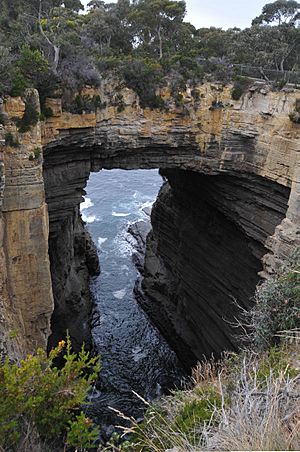Tasman National Park facts for kids
Quick facts for kids Tasman National ParkTasmania |
|
|---|---|
|
IUCN Category II (National Park)
|
|

Sunrise at Fortescue Bay
|
|
| Nearest town or city | Port Arthur |
| Established | 30 April 1999 |
| Area | 107.5 km2 (41.5 sq mi) |
| Managing authorities | Tasmania Parks and Wildlife Service |
| Website | Tasman National Park |
| See also | Protected areas of Tasmania |
The Tasman National Park is a beautiful national park located in eastern Tasmania, Australia. It's about 56 kilometers (35 miles) east of Hobart, the capital city. This park covers an area of 107.5 square kilometers (41.5 square miles). It includes parts of both the Forestier and Tasman peninsulas. The entire Tasman Island is also part of this amazing park.
Contents
History of Tasman National Park

Long ago, in the 1830s and 1840s, people used to hunt whales in this area.
The Tasman National Park was officially created on April 30, 1999. This happened as part of a special agreement about forests. A famous landmark, the Tasman Island Lighthouse, stands on Tasman Island within the park. It was built in 1906. Since 1977, this lighthouse and its weather station have been controlled automatically, without people living there.
Amazing Geography
The park is famous for its incredibly tall cliffs. At Cape Pillar and Tasman Island, these cliffs reach about 300 meters (980 feet) above sea level. They are made of a special rock called dolerite. These dolerite cliffs are among the highest in the world! Dolerite rock is quite rare on mainland Australia.
You can visit some cool rock formations by car. These include the Blowhole, which is a hole at the end of a sea cave. There's also Devils Kitchen, which is a rock hole, and Waterfall Bay. Other amazing dolerite formations are best seen from the ocean. These include Cathedral Rock, the Totem Pole, the Candlestick, and Tasmans Arch. The park also has three small islands known as The Lanterns.
Unique Plants (Flora)
The Tasman National Park is home to some very special plants. Three types of Euphrasia, also known as eyebright, grow only here. These are small flowering plants that get some of their food from other plants.
Another rare plant found only in this park is the Cape Pillar Sheoak. This is a shrub or small tree. It grows only in the Cape Pillar area of the Tasman Peninsula and on Tasman Island.
Sadly, Giant Kelp forests near Eaglehawk Neck have disappeared since 2016. This is due to climate change. Scientists predict that Tasmania's remaining giant kelp forests might vanish in the next five to ten years.
Wonderful Animals (Fauna)
The park's coastline is a vital place for Australian fur seals. They use it for breeding and resting. You can also see little penguins nesting along the shore. These penguins are sometimes called "blue penguins" or "fairy penguins."
The Tasman National Park is also very important for birds. It's part of the South-east Tasmania Important Bird Area. This area helps protect many woodland birds. Two very special birds here are the swift parrot and the forty-spotted pardalote. Both of these birds are endangered, meaning they are at risk of disappearing forever.
Three Capes Track: An Adventure Walk
The Three Capes Track is an exciting walking trail in Tasman National Park. It's a one-way, 46-kilometer (28.5-mile) journey that takes three nights to complete. The track opened on December 25, 2015.
Your adventure starts at the Port Arthur Historic Sites. From there, a boat takes walkers around the bay of Port Arthur. You then get off at Denmans Cove. From Denmans Cove, you trek 46 kilometers to Fortescue Bay. Along the way, you stop each night at special huts. These huts provide water, gas cookers for cooking, toilets, and places to sleep. A Tasmanian Parks and Wildlife Ranger is at each hut, and another ranger patrols between them. Each hut can host 48 people per night.
This 4-day walk takes you to amazing places like Cape Pillar, Cape Hauy, Mount Fortescue, Arthurs Peak, and Ellarwey Valley. The journey ends at Fortescue Bay. Building this track was a big project, costing 25 million Australian dollars. This included 18,000 helicopter flights to bring materials to the remote sites. Before this new track, there was an older, less maintained path from 1990. The idea for the Three Capes Track actually started way back in the mid-1960s!
See also
 In Spanish: Parque nacional de Tasman para niños
In Spanish: Parque nacional de Tasman para niños


